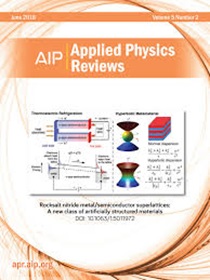组织工程中聚偏氟乙烯基压电材料的器官协同作用
IF 11.6
1区 物理与天体物理
Q1 PHYSICS, APPLIED
引用次数: 0
摘要
聚偏氟乙烯(PVDF)基压电材料由于其独特的模拟内源性生物电信号的能力而成为组织工程中的一个变革平台,而内源性生物电信号在细胞行为,如增殖、分化和组织再生中起着关键作用。本文综述了PVDF及其共聚物的结构多态性、加工技术和机电性能,重点介绍了PVDF及其共聚物优越的压电系数、生物相容性和对多种制备方法的适应性。PVDF的内在压电性,由其极性β相驱动,能够对机械刺激(如生理运动或外力)做出动态响应,产生局部电位,调节关键信号通路,增强组织修复。应用范围涉及多个器官:在骨再生中,PVDF支架通过机电耦合促进成骨;在神经工程中,它们促进轴突生长和髓鞘形成;在心脏修复中,它们同步心肌细胞收缩;在皮肤愈合过程中,它们加速了表皮再生和血管生成。尽管取得了这些进步,但挑战依然存在,包括优化压电输出、确保长期生物相容性和实现可控的生物降解性。未来的方向强调PVDF与智能功能的整合和器官特异性信号机制的探索,以推进临床翻译。这项工作强调了pvdf基材料作为下一代再生治疗的多功能平台的潜力。本文章由计算机程序翻译,如有差异,请以英文原文为准。
Organ synergy in poly(vinylidene fluoride)-based piezoelectrical materials for tissue engineering
Poly(vinylidene fluoride) (PVDF)-based piezoelectric materials have emerged as a transformative platform in tissue engineering due to their unique ability to mimic endogenous bioelectric signals, which play pivotal roles in cellular behaviors, such as proliferation, differentiation, and tissue regeneration. This review comprehensively explores the structural polymorphism, processing techniques, and electromechanical properties of PVDF and its copolymers, emphasizing their superior piezoelectric coefficients, biocompatibility, and adaptability to diverse fabrication methods. The intrinsic piezoelectricity of PVDF, driven by its polar β-phase, enables dynamic responses to mechanical stimuli, such as physiological movements or external forces, generating localized electrical potentials that modulate critical signaling pathways to enhance tissue repair. Applications span multiple organs: in bone regeneration, PVDF scaffolds promote osteogenesis through mechanoelectrical coupling; in neural engineering, they facilitate axonal growth and myelination; in cardiac repair, they synchronize cardiomyocyte contraction; and in skin healing, they accelerate re-epithelialization and angiogenesis. Despite these advances, challenges persist, including optimizing piezoelectric output, ensuring long-term biocompatibility, and achieving controlled biodegradability. Future directions highlight the integration of PVDF with smart functionalities and the exploration of organ-specific signaling mechanisms to advance clinical translation. This work underscores the potential of PVDF-based materials as multifunctional platforms for next-generation regenerative therapies.
求助全文
通过发布文献求助,成功后即可免费获取论文全文。
去求助
来源期刊

Applied physics reviews
PHYSICS, APPLIED-
CiteScore
22.50
自引率
2.00%
发文量
113
审稿时长
2 months
期刊介绍:
Applied Physics Reviews (APR) is a journal featuring articles on critical topics in experimental or theoretical research in applied physics and applications of physics to other scientific and engineering branches. The publication includes two main types of articles:
Original Research: These articles report on high-quality, novel research studies that are of significant interest to the applied physics community.
Reviews: Review articles in APR can either be authoritative and comprehensive assessments of established areas of applied physics or short, timely reviews of recent advances in established fields or emerging areas of applied physics.
 求助内容:
求助内容: 应助结果提醒方式:
应助结果提醒方式:


